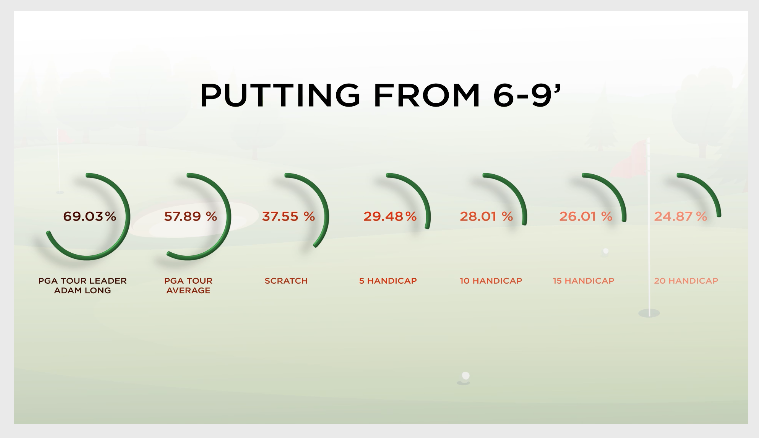[PHOTO: Michael Reaves]
Short putting is where pros make their money, and the rest of us shave strokes off our handicaps.
There truly are few areas of golf more important that your putting performance between five and 10 feet. Hit a couple of iron shots six feet closer during your round and there’s a good chance your scores won’t show it. Start holing a couple of extra six-footers during your round, and the payoff will be instant.
Simply putt, there’s a direct correlation between how good you are from inside 10 feet, and how low your handicap is. The more the better, as you can see below:

But knowing they’re important is important. How do you actually get better at it?
That’s what I asked Denny McCarthy, on the grounds at the FedEx St Jude Championship this week. McCarthy currently ranks 27th in the FedEx Cup standings. Long regarded as one of the best putters on tour, he currently ranks third in Strokes Gained: Putting this season, and leads the tour in putting inside 10 feet.
Good short-range putting, McCarthy says, ultimately comes down to good speed control. Whereas on longer putts you can get away with less-than-perfect green reading if your speed control is good, on shorter putts, your goal is to match the right line with the right speed. You need both to make those shorter ones consistency.
Here’s his advice to help you find both.
1. Don’t lock into one speed
What’s the perfect speed to hit your putts? Some players will tell you they prefer to die their ball slowly into the hole. Others prefer to roll it in firmly, with pace. To each their own. But McCarthy says for him, the best speed depends on the putt itself.
“I don’t have a formula,” he says. “I used to struggle with speed as a junior. But as a professional, I learned to hone and trust my instructs. I stuck to my own process. The more I did that, the better my putting got.”

Part of that process, he says, was learning to work backwards from the putt itself. What’s the ideal way of hitting the specific putt in front of him?
“If I have a downhill putt or am putting on slippery greens, I’m not going to risk running it seven feet past because I want to make it,” he says. “I never go into a putt thinking about how hard I want to hit the putt. I’m letting the slopes dictate the speed to me.”
Sometimes he’ll opt for a firm roll. Other times, a softer roll. It all comes down to the slopes, which hold the key to speed.
2. Let slopes dictate speed
Letting the slopes dictate the speed is, ultimately, the key tenet of McCarthy’s process when it comes to speed control. McCarthy says that once he sizes up the break, he’ll pick a spot to aim for. Then, he’ll set up to his ball aiming at that spot, and ask himself: “Does this feel comfortable?”
That’s when he starts mentally moving that aiming spot around.

“If I pick a spot, and it feels low, I know that means I’d have to hit that with too much pace in order for it to go in. If it pick a spot way up on a slope, I’ll know I have to hit that pretty soft in order for that to go in,” he says. “I’m basically looking for a spot that feels just right.”
It’s the spot that dictates the pace, he says. And it could be different each day. Some days he may prefer the lower routes. On certain putts, he may opt for higher spots. It’s all about comfort and confidence. And once he’s found his most comfortable one for that spot, he’s found the speed. There’s only one thing left to do…
3. Never think about the consequences of a missed putt
At some point, you’ve done all your thinking and planning. It’s time to commit. For that, McCarthy has a simple approach.
“Never think about the consequences of leaving it short or rolling it past,” he says. “When I’m over the putt, I’m just solely focused on the putt itself. I trust in what I’m doing, and that gives me the belief that I’ll hole the putt.”



